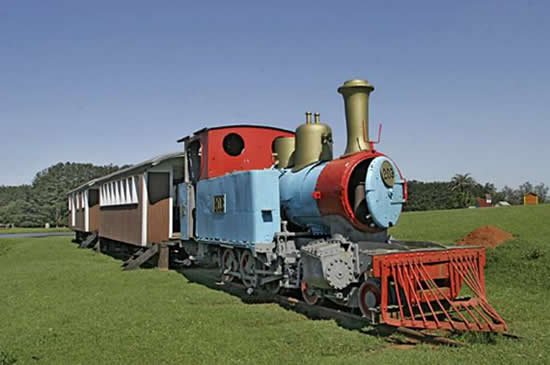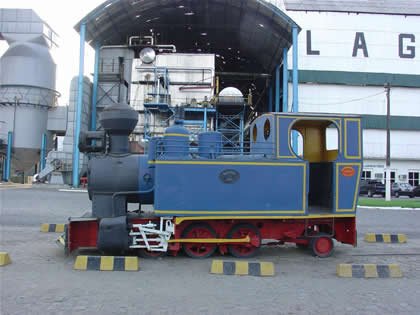The World War I trench locomotives:
the English side

The 203 was used for construction of the Palmares-Osorio RR |
Sergio Martire
We previously focused on the locomotives used by the Imperial German Army, the so-called Brigadiers, on the European front (see “Prisoners of War,” in “Articles”). In search of steam engines during the Memória Ferroviária Project, we found another two locomotives that according to the original project were to have been used by the British Expeditionary Force during the 1914-1918 World War.
During the conflict, the British War Department ordered a series of steam engines from British manufacturers that would be used for transportation between the front lines occupied by British troops.
The specifications were the same as for the armies of France, the Austro-Hungarian Empire and Germany: the locomotives had to be strong, easily repaired, small in size and run on 600 mm-gauge track, the same use by all of the belligerent troops, thus facilitating things when enemy rolling stock was captured. It was a concept use by all of the participants in the war. The Hunslet Engine Co. of Leeds received a significant part of the order, delivering the engines within the deadline required by the English War Department. However, the steam engines arrived too late to actually participate in the conflict. The English government then sold the group of engines at public auction and almost all of the existing builders of steam engines on the British Isles made bids.
Hunslet repurchased a quantity of the locomotives because after 1918 there was great demand for them due to the rebuilding needs of the belligerent states.
The 203
The two Hunslet locomotives we found are in a preserved state inside the Parque Pampas Safári theme park at Gravataí, Rio Grande do Sul, together with two passenger cars. With prefix 203, the engine was part of an order of four units, all for 600-mm gauge track, suppled by Hunslet for the builder of the Palmares to Osório Railroad in Rio Grande do Sul, eradicated in the 1960s. The 203 has a 4-6-0T wheelset and still displays the manufacturer’s identification plaque: production number 1312, year 1918. It also has a British Defense Department identification tag (ROD No 2340). It did not require any major modifications because the four engines worked on a 600 mm-gauge track under construction at the time, known as the colonial railroad and notable for its low construction cost and few geographical accidents. The railroad’s builder also supplied passenger cars manufactured by the Trajano de Medeiros company of Rio de Janeiro, using 4-wheel trucks.

Number 10 was substantially modified from its original manufacturing state. |
In Alagoas
The history of the other locomotive we found is much more complex. Repurchased by Hunslet, it remained until 1921 within the manufacturer’s facilities, awaiting a purchaser. The English company Robert Hudson eventually bought it and sent it to the Usina Leão Utinga sugar mill in Rio Largo, Alagoas, where it was baptized Number 10.
There is conflicting information among specialists regarding the services this Hunslet engine carried out on behalf of Hunslet or Robert Hudson. Some historians affirm Robert Hudson modified the original 600-mm gauge to one-meter and that the rear part of the chassis was reversed. Others state that Hunslet itself modified the original 600 meter-guage for one-meter, addingh a larger coal box, a new cabin, a new seal for the smokestack, which was supported by a wider chassis and a new, larger-capacity boiler. The engine was named “Pão Amarelo.” In another modification made by the sugar mill, the locomotive, which had a 4-6-0T wheelset, was changed to 0-6-2T. The Usina Leão Utinga sold No. 10 to Usina Laginha during the 1950s.
The specifications of the two locomotives are shown in the following table.
| Prefix |
203 |
10 |
| Production number |
1312 |
1313 |
| Year produced |
1918 |
1921 |
| Wheelset |
4-6-0T |
0-6-2T |
| Gauge mm |
600 |
1,000 |
| Length mm |
5,700 |
5,200 |
| Wheel diameter mm |
600 |
600 |
| Cylinder diameter mm |
350 |
400 |
| Piston stroke mm |
320 |
400 |
| Boiler diameter mm |
800 |
960 |
|










